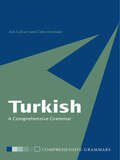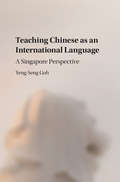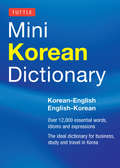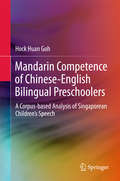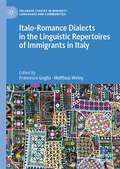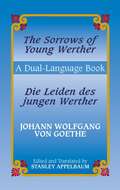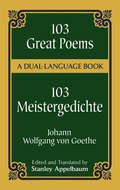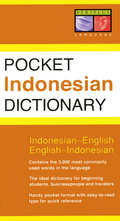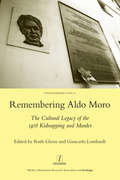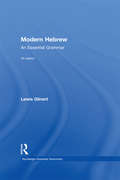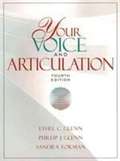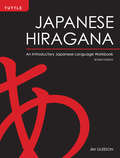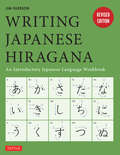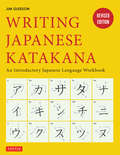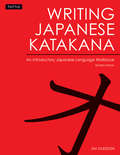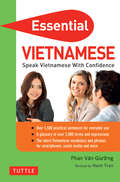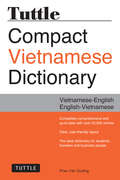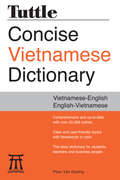- Table View
- List View
Turkish: A Step-by-step Approach For Chemical Engineers (Routledge Comprehensive Grammars)
by Aslı Göksel Celia KerslakeTurkish: A Comprehensive Grammar is a complete reference guide to modern Turkish grammar. Concentrating on the real patterns of use in modern Turkish, it presents a detailed and systematic description of the structure of language at every level:sounds, words and sentences and will remain the standard reference work for years to come. Drawing upon a rapidly growing body of scholarly research on Turkish, this well-presented Grammar is a stimulating and up-to-date analysis of the complexities of the language, with full and clear explanations and examples throughout. A detailed index and extensive cross-referencing between numbered subsections also provides readers with easy access to the information they require. Features include: detailed treatment of common grammatical structures and parts of speech extensive use of examples, all with English translations particular attention to areas of confusion and difficulty comprehensive glossary of all grammatical terms. The Grammar is an essential reference source for intermediate and advanced learners and users of Turkish. It is ideal for use in schools, colleges, universities and adult classes of all types.
Teaching Chinese as an International Language: A Singapore Perspective
by Goh Yeng-SengBilingual and bicultural scholar Yeng-Seng Goh offers the first in-depth English language analysis of global Chinese, exploring the spread of Chinese beyond China and its emergence as a global language. Approaching the topic from a Singapore perspective, Goh uses this fascinating language ecosystem, with its unique bilingual language policy, as a case study for Chinese language learning. Offering clear insights into the pedagogy of teaching Chinese as an international language (TCIL), this book covers a range of important topics, such as the use of English in the teaching of Chinese, the teaching of Chinese by non-native teachers, information and communications technology in L2 learning and teaching, and the progressive testing of receptive skills. In doing so, it presents a new, integrative approach to the compilation of Chinese learner's dictionaries, an innovative bilingual hybrid model for training TCIL teachers, and a solid theoretical framework for Masters of Arts programmes in TCIL.
Tuttle Mini Korean Dictionary: Korean-English English-Korean
by Nancy GohThis is a completely up-to-date Korean mini dictionary.Tuttle Mini Korean Dictionary is ideal for any application where a handy and portable dictionary is required.<P><P> Intended for use by tourists, students, and business people traveling to Korea or as a Korean language study reference Mini Korean Dictionary is an essential tool for communicating in Korean. It's useful pocket-sized format and easy-to read type will make translating Korean much easier. In addition to being an excellent English to Korean dictionary and Korean to English dictionary Mini Korean Dictionary contains important notes on the Korean language, Korean grammar and Korean pronunciation. All Korean words are written in a Romanized form as well as Korean script (hangul) so that in the case of difficulties the book can simply be shown to the person the user is trying to communicate with.This mini dictionary contains the following essential features:Bidirectional Korean to English and English to KoreanOver 12,000 essential Korean words, as well as useful Korean expressions and idiomsHeadwords printed in blue for quick and easy referenceA basic overview of Korean grammar and pronunciationAll the latest Korean social media and computer terms
Mandarin Competence of Chinese-English Bilingual Preschoolers
by Hock Huan GohThis book provides readers with a detailed sketch of the Mandarin competence of Chinese children in Singapore from different home language backgrounds. Their Mandarin competence is defined in terms of lexical diversity, syntactic complexity and code-switching tendency. The findings presented show that there are statistical differences in lexical diversity and syntactic complexity among the compared groups of children, and these differences in linguistic competence were found to be positively correlated to increased Mandarin exposure at home. They also demonstrate that there are statistical differences in code-switching tendency among the groups of children compared, which were found to be negatively correlated to increased exposure to Mandarin at home. A general relationship between home language exposure and Mandarin competence was established, although this relationship was found to be volatile, especially among children who are more bilingually exposed. This book shares these findings with linguists, language educators, and language policymakers, both local and international.
Italo-Romance Dialects in the Linguistic Repertoires of Immigrants in Italy (Palgrave Studies in Minority Languages and Communities)
by Francesco Goglia Matthias WolnyThis edited book brings together experts on the sociolinguistics of immigration with a focus on the Italo-Romance dialects. Sociolinguistic research on immigrant communities in Italy has widely studied the acquisition and use of Italian as L2 by first-generation immigrants, the maintenance of immigrant languages and code-switching between Italian and the immigrant languages. However, these studies have mostly ignored or neglected to investigate immigrant speakers’ use of Italo-Romance dialects, their awareness of the sociolinguistic situation of majority and minority languages, and their attitudes towards them. Given the important role of Italo-Romance dialects in everyday communication and as a marker of regional identity, this book aims to fill this gap and understand more about the role that these languages play in the linguistic repertoire of immigrants. This book will be of interest to students and scholars of sociolinguistics, minority languages, multilingualism, migration, and social anthropology.
The Sorrows of Young Werther/Die Leiden des jungen Werther: A Dual-Language Book
by Johann Wolfgang Goethe Stanley AppelbaumLoosely based on Goethe's personal experiences, the novel is written mostly in the form of letters in which Werther recounts his unrequited love for a married woman. Its Sturm und Drang style, portraying the rebellion of youthful genius against conventional standards, makes it a perennial favorite with readers of every era.
103 Great Poems: A Dual-Language Book
by Johann Wolfgang GoetheJohann Wolfgang von Goethe (1749-1832) produced a large body of fine literature that includes novels, plays, stories, scientific treatises, travelogues, and other prose. His ballads, elegies, and lyric poems rank among his finest works. This dual-language edition, spanning a wide range of styles, forms, and moods, presents a rich selection of Goethe's verse in the original German with excellent line-for-line English translations on facing pages.Featured masterworks include "Prometheus," typical of the Sturm und Drang (storm and stress) period; "Rastlose Liebe" ("Restless Love") and "An den Mond" ("To the Moon"), lyric pieces of intense beauty; the narrative ballads "Der Fischer" ("The Fisherman") and "Erlkönig" ("Elf King"); and other poems of timeless beauty and resonance. In addition to an informative introduction, this edition offers a commentary on each poem that will provide valuable insights for students, teachers, and other readers.
Pocket Indonesian Dictionary
by Zane Goebel Junaeni GoebelThis is a pocket sized Indonesian Dictionary Intended for use by tourists, students, and business people traveling to Indonesia Pocket Indonesian Dictionary is an essential tool for communicating in Indonesian. It features all the essential Indonesian vocabulary appropriate for beginning to intermediate students. It's handy pocket format and easy-to read type will make any future trip to Indonesia much easier. In addition to being an excellent English to Indonesian dictionary and Indonesian to English dictionary Pocket Indonesian Dictionary contains important notes on the Indonesian language, Indonesian grammar and Indonesian pronunciation. All Indonesian words are written in English as well as Indonesian script so that in the case of difficulties the book can simply be shown to the person the user is trying to communicate with. This dictionary contains: The 3,000 most commonly used words in the Indonesian language. English and Romanized Indonesian. An introduction to and history of the Indonesian language. Information on Indonesian grammar. A guide to pronouncing Indonesian correctly. Other books from this bestselling series you might enjoy are: Pocket Tagalog Dictionary, Pocket Vietnamese Dictionary, Pocket Mandarin Chinese Dictionary, Pocket Cantonese Dictionary, Pocket Cambodian Dictionary, Pocket Thai Dictionary, and Pocket Malay Dictionary.
Pocket Indonesian Dictionary
by Zane Goebel Junaeni GoebelThis is a pocket sized Indonesian DictionaryIntended for use by tourists, students, and business people traveling to Indonesia Pocket Indonesian Dictionary is an essential tool for communicating in Indonesian. It features all the essential Indonesian vocabulary appropriate for beginning to intermediate students. It's handy pocket format and easy-to read type will make any future trip to Indonesia much easier. In addition to being an excellent English to Indonesian dictionary and Indonesian to English dictionary Pocket Indonesian Dictionary contains important notes on the Indonesian language, Indonesian grammar and Indonesian pronunciation. All Indonesian words are written in English as well as Indonesian script so that in the case of difficulties the book can simply be shown to the person the user is trying to communicate with.This dictionary contains: The 3,000 most commonly used words in the Indonesian language. English and Romanized Indonesian. An introduction to and history of the Indonesian language. Information on Indonesian grammar. A guide to pronouncing Indonesian correctly.Other books from this bestselling series you might enjoy are: Pocket Tagalog Dictionary, Pocket Vietnamese Dictionary, Pocket Mandarin Chinese Dictionary, Pocket Cantonese Dictionary, Pocket Cambodian Dictionary, Pocket Thai Dictionary, and Pocket Malay Dictionary.
Pocket Indonesian Dictionary
by Junaeni Goebel Zane GoebelThis is a pocket sized Indonesian DictionaryIntended for use by tourists, students, and business people traveling to Indonesia Pocket Indonesian Dictionary is an essential tool for communicating in Indonesian. It features all the essential Indonesian vocabulary appropriate for beginning to intermediate students. It's handy pocket format and easy-to read type will make any future trip to Indonesia much easier. In addition to being an excellent English to Indonesian dictionary and Indonesian to English dictionary Pocket Indonesian Dictionary contains important notes on the Indonesian language, Indonesian grammar and Indonesian pronunciation. All Indonesian words are written in English as well as Indonesian script so that in the case of difficulties the book can simply be shown to the person the user is trying to communicate with.This dictionary contains: The 3,000 most commonly used words in the Indonesian language. English and Romanized Indonesian. An introduction to and history of the Indonesian language. Information on Indonesian grammar. A guide to pronouncing Indonesian correctly.Other books from this bestselling series you might enjoy are: Pocket Tagalog Dictionary, Pocket Vietnamese Dictionary, Pocket Mandarin Chinese Dictionary, Pocket Cantonese Dictionary, Pocket Cambodian Dictionary, Pocket Thai Dictionary, and Pocket Malay Dictionary.
An Introduction to Japanese Kanji Calligraphy
by Bob Godin Takezaki KuniiThis step-by-step Japanese calligraphy book explains the systems of Japanese language and delves into details of written Japanese characters and techniques of kanji calligraphy.The word calligraphy literally means "beautiful writing." It is an art form that can be found in most civilizations with a written script. Originally developed to stress the importance of culture, religion and philosophy, over time calligraphy in most languages has developed into a purely artistic expression.In Japanese culture, kanji characters from the Japanese writing system are used in calligraphy. An Introduction to Japanese Kanji Calligraphy is an exploration of this Asian art form, and examines how calligraphic poetry developed in Japan. Written by a Japanese shodo master, it is a wonderful introduction to the beautiful art of Japanese calligraphy.Japanese Kanji Calligraphy includes:An introduction to Japanese calligraphy Background information on the modern Japanese language Hiragana and katakana charts An explanation of the tools of calligraphy A guide to correct calligraphy techniques Step-by-step calligraphy instructions An extensive kanji character library
Remembering Aldo Moro: The Cultural Legacy of the 1978 Kidnapping and Murder
by Ruth GlynnThe 1978 kidnapping and murder of Christian Democrat politician, Aldo Moro, marked the watershed of Italy's experience of political violence in the period known as the 'years of lead' (1969-c.1983). This uniquely interdisciplinary volume explores the evolving legacy of Moro's death in the Italian cultural imaginary, from the late 1970s to the present. Bringing a wide range of critical perspectives to bear, interventions by experts in the fields of political science, social anthropology, philosophy, and cultural critique elicit new understandings of the events of 1978 and explain their significance and relevance to present-day Italian culture and society.
Modern Hebrew: An Essential Grammar (Routledge Essential Grammars Ser.)
by Lewis GlinertThis fourth edition of Hebrew: An Essential Grammar includes expanded coverage of some of the key areas of Hebrew grammar including roots, adverbs and nouns. Additional examples have been added throughout to further clarify many of the grammar points with illustrations from current usage. The Grammar serves as a reference source for the learner or user of Hebrew irrespective of level, by setting out the complexities of the language in short, readable sections that are clear and free from jargon. It is ideal both for independent study and for students on taught course.
Your Voice And Articulation (Fourth Edition)
by Ethel C. Glenn Phillip J. Glenn Sandra H. FormanFourth edition of a text which offers explanations of the processes by which we produce voice and speech sounds, such as consonants and vowels, in American English. Included are exercises and practice guidelines for enhancing or correcting voice quality and the pronunciation of sounds and words.
Japanese Hiragana
by Jim GleesonThis workbook has been carefully designed to facilitate the quick and easy mastery of the forty-six character hiragana syllabary used to write all types of native words not written in kanji.Each character is introduced here with brushed, handwritten, and typed samples to enhance character recognition. Entertaining illustrations and amusing examples of onomatopoeic usage of hiragana in Japanese writings further reinforce memorization in a fun way.This easy-to-use and practical workbook is well suited for beginning students of all ages. This revised edition has 16 more pages of exercises and additional practice pages.
Japanese Hiragana
by Jim GleesonThis workbook has been carefully designed to facilitate the quick and easy mastery of the forty-six character hiragana syllabary used to write all types of native words not written in kanji.Each character is introduced here with brushed, handwritten, and typed samples to enhance character recognition. Entertaining illustrations and amusing examples of onomatopoeic usage of hiragana in Japanese writings further reinforce memorization in a fun way.This easy-to-use and practical workbook is well suited for beginning students of all ages. This revised edition has 16 more pages of exercises and additional practice pages.
Writing Japanese Hiragana
by Jim GleesonThis guide presents exercises, review practices and lively illustrations, helping the reader to learn to write Hiragana.
Writing Japanese Hiragana
by Jim GleesonPut simply, practice is the most effective method of mastering written Japanese. The large, open format of Writing Japanese Hiragana invites the student to pick up a pencil and get started!Two phonetic syllabaries, hiragana and katakana, and a set of kanji characters based on Chinese ideographs are what comprises written Japanese. This workbook has been carefully designed to facilitate the quick and easy mastery of the forty-six character hiragana syllabary used to write all types of native words not written in kanji. An understanding of hiragana is essential for the serious student wishing to learn Japanese effectively.Each character is introduced with brushed, handwritten, and typed samples which enhance character recognition. Extensive writing space allows for maximum practice to facilitate memorization and ensure proper character formation. Entertaining illustrations and amusing examples of onomatopoeic usage of hiragana in Japanese writings further reinforce memorization in a fun way.Writing Japanese Hiragana is an easy-to-use and practical workbook tailored to the specific needs of young students of the Japanese language. Beginning students of all ages will delight in its fresh presentation.
Writing Japanese Hiragana
by Jim GleesonPut simply, practice is the most effective method of mastering written Japanese. The large, open format of Writing Japanese Hiragana invites the student to pick up a pencil and get started!Two phonetic syllabaries, hiragana and katakana, and a set of kanji characters based on Chinese ideographs are what comprises written Japanese. This workbook has been carefully designed to facilitate the quick and easy mastery of the forty-six character hiragana syllabary used to write all types of native words not written in kanji. An understanding of hiragana is essential for the serious student wishing to learn Japanese effectively.Each character is introduced with brushed, handwritten, and typed samples which enhance character recognition. Extensive writing space allows for maximum practice to facilitate memorization and ensure proper character formation. Entertaining illustrations and amusing examples of onomatopoeic usage of hiragana in Japanese writings further reinforce memorization in a fun way.Writing Japanese Hiragana is an easy-to-use and practical workbook tailored to the specific needs of young students of the Japanese language. Beginning students of all ages will delight in its fresh presentation.
Writing Japanese Katakana
by Jim GleesonThis is an introductory guide and workbook to writing Japanese Katakana.Anybody who is able to master English, with its irregular spellings and idiosyncratic pronunciations, is more than equipped to master written Japanese. The hiragana and katakana syllabaries are purely phonetic characters, which function much like the letters of the English alphabet. In this respect, kana are quite different from kanji characters, which are based on Chinese ideographs and which represent ideas. The katakana syllabary is used primarily to represent borrowed words (from languages other than Chinese), although it is also used for botanical names and is sometimes used in place of hiragana or kanji for emphasis. In some ways, the use of katakana in Japanese parallels the use of italics in English.Writing practice is the most effective method of mastering written Japanese, and the large open format of this workbook is designed to invite the student to pick up a pencil and start writing. Written Japanese comprises two phonetic syllabaries, hiragana and katakana, and a set of kanji characters that are based on Chinese ideographs. This workbook has been carefully designed to facilitate the quick and easy mastery of the 46-character katakana alphabet, making it the perfect tool to begin the process of mastering written Japanese. Each character is introduced with brushed, handwritten and typed samples that enhance character recognition. Extensive space for writing allows maximum practice to facilitate memorization and to ensure proper character formation. Entertaining illustrations and amusing examples of loan-words that use katakana in Japanese writings further reinforce memorization in a fun way. Writing Katakana is tailored to the specific needs of young students of the Japanese language, but is also well suited to beginning students of any age. This workbook contains: grayed-out, trace-over characters for correct character construction. Extensive practice in writing sentences for maximum reinforcement. Supplementary explanations, including a brief history of the origin of each character, to foster visual recall.
Writing Japanese Katakana
by Jim GleesonThis is an introductory guide and workbook to writing Japanese Katakana.Anybody who is able to master English, with its irregular spellings and idiosyncratic pronunciations, is more than equipped to master written Japanese. The hiragana and katakana syllabaries are purely phonetic characters, which function much like the letters of the English alphabet. In this respect, kana are quite different from kanji characters, which are based on Chinese ideographs and which represent ideas. The katakana syllabary is used primarily to represent borrowed words (from languages other than Chinese), although it is also used for botanical names and is sometimes used in place of hiragana or kanji for emphasis. In some ways, the use of katakana in Japanese parallels the use of italics in English.Writing practice is the most effective method of mastering written Japanese, and the large open format of this workbook is designed to invite the student to pick up a pencil and start writing. Written Japanese comprises two phonetic syllabaries, hiragana and katakana, and a set of kanji characters that are based on Chinese ideographs. This workbook has been carefully designed to facilitate the quick and easy mastery of the 46-character katakana alphabet, making it the perfect tool to begin the process of mastering written Japanese. Each character is introduced with brushed, handwritten and typed samples that enhance character recognition. Extensive space for writing allows maximum practice to facilitate memorization and to ensure proper character formation. Entertaining illustrations and amusing examples of loan-words that use katakana in Japanese writings further reinforce memorization in a fun way. Writing Katakana is tailored to the specific needs of young students of the Japanese language, but is also well suited to beginning students of any age. This workbook contains:grayed-out, trace-over characters for correct character constructionExtensive practice in writing sentences for maximum reinforcementSupplementary explanations, including a brief history of the origin of each character, to foster visual recall.
Writing Japanese Katakana
by Jim GleesonThis is an introductory guide and workbook to writing Japanese Katakana.Anybody who is able to master English, with its irregular spellings and idiosyncratic pronunciations, is more than equipped to master written Japanese. The hiragana and katakana syllabaries are purely phonetic characters, which function much like the letters of the English alphabet. In this respect, kana are quite different from kanji characters, which are based on Chinese ideographs and which represent ideas. The katakana syllabary is used primarily to represent borrowed words (from languages other than Chinese), although it is also used for botanical names and is sometimes used in place of hiragana or kanji for emphasis. In some ways, the use of katakana in Japanese parallels the use of italics in English.Writing practice is the most effective method of mastering written Japanese, and the large open format of this workbook is designed to invite the student to pick up a pencil and start writing. Written Japanese comprises two phonetic syllabaries, hiragana and katakana, and a set of kanji characters that are based on Chinese ideographs. This workbook has been carefully designed to facilitate the quick and easy mastery of the 46-character katakana alphabet, making it the perfect tool to begin the process of mastering written Japanese. Each character is introduced with brushed, handwritten and typed samples that enhance character recognition. Extensive space for writing allows maximum practice to facilitate memorization and to ensure proper character formation. Entertaining illustrations and amusing examples of loan-words that use katakana in Japanese writings further reinforce memorization in a fun way. Writing Katakana is tailored to the specific needs of young students of the Japanese language, but is also well suited to beginning students of any age. This workbook contains:grayed-out, trace-over characters for correct character constructionExtensive practice in writing sentences for maximum reinforcementSupplementary explanations, including a brief history of the origin of each character, to foster visual recall.
Essential Vietnamese
by Phan Van Giuong Hanh TranThis is a compact and user-friendly Vietnamese Phrasebook and guide to the Vietnamese language, Essential Vietnamese contains basic Vietnamese vocabulary and grammar necessary for communicating in Vietnamese.Learning Vietnamese and engaging in Vietnamese conversation is made easier, more accessible, and more enjoyable in this new Vietnamese phrase book, Essential Vietnamese. One of the best resources to learn Vietnamese, this book presents practical language of everyday interactions by incorporating fundamental sentences used when meeting people, starting conversations, and asking and replying to questions in Vietnamese, as well as a basic grammar and pronunciation guide to help you start speaking Vietnamese right away.In addition, language involving terms and phrases covering the latest technology devices, using social media, and tips on the essentials of travel like arranging accomodations, dining out, dealing with transportation and emergencies, is also effectively covered in extraordinary detail.Essential Vietnamese includes: Over 1,500 essential sentences for everyday use A glossary containing over 2,000 terms and expressions A handy format for finding the information you need quickly and easily Latest Vietnamese vocabulary and phrases for smart phones, social media and more
Tuttle Compact Vietnamese Dictionary: Vietnamese-English English-Vietnamese
by Phan Van GiuongThis is a compact and user-friendly Vietnamese dictionary.The Tuttle Compact Vietnamese Dictionary is the most up-to-date and complete Vietnamese dictionary yet published. An essential tool to learn Vietnamese, it is written for English speakers and other non-native users who need to look up Vietnamese terms, and can also be used by Vietnamese speakers who are learning English. This dictionary has 25,000 entries covering all contemporary terms likely to be used in educational or business settings. The layout is user-friendly and attractive. Headwords are displayed in blue-this helps the reader to locate words quickly. Information on parts of speech, idiomatic expressions and sample sentences showing the us of the words in context are given for each entry. English pronunciations are given in the English to Vietnamese language section. A comprehensive pronunciation guide and detailed notes on Japanese grammar are also included. Completely comprehensive and up-to-date with over 25,000 entries.Contains English-Vietnamese and Vietnamese-English Clear, user-friendly layout with idioms, and sample sentences given. The ideal dictionary for students, teachers and business people.
Tuttle Concise Vietnamese Dictionary: Vietnamese-English English-Vietnamese
by Phan Van GiuongTuttle Concise Vietnamese Dictionary is the most up-to-date compact Vietnamese dictionary available today.<P><P>It is designed for English speakers who are studying the Vietnamese language, traveling to Vietnam, or using the language on a daily basis to interact with Vietnamese speakers. It has both Vietnamese to English and English to Vietnamese sections, with enough depth that it may also be used by Vietnamese speakers who are learning or using English. It's depth makes it a great way to learn Vietnamese.Divided into two parts-Vietnamese-English and English-Vietnamese-this concise dictionary has a total of 25,000 entries. The entries given within each section include all everyday words and expressions used in educational, cultural and tourism contexts in Vietnam today. The entries give core information about: Parts of speech of the headwords. Useful meanings, common collocations, idiomatic expressions and sample sentences. Vietnamese loanwords, many from French, list the original source word as well as alternate Vietnamese words with the same meaning. English entries provide additional information such as alternate British or American spellings, singular and plural forms, and irregular verb forms.Contemporary internet, computer and mobile phone terms are included, making this dictionary invaluable everyday use. A guide to Vietnamese pronunciation and spelling, and other grammar pointers and explanations are also included. The Tuttle Concise Vietnamese Dictionary is an compact and comprehensive tool for successful language learning.
